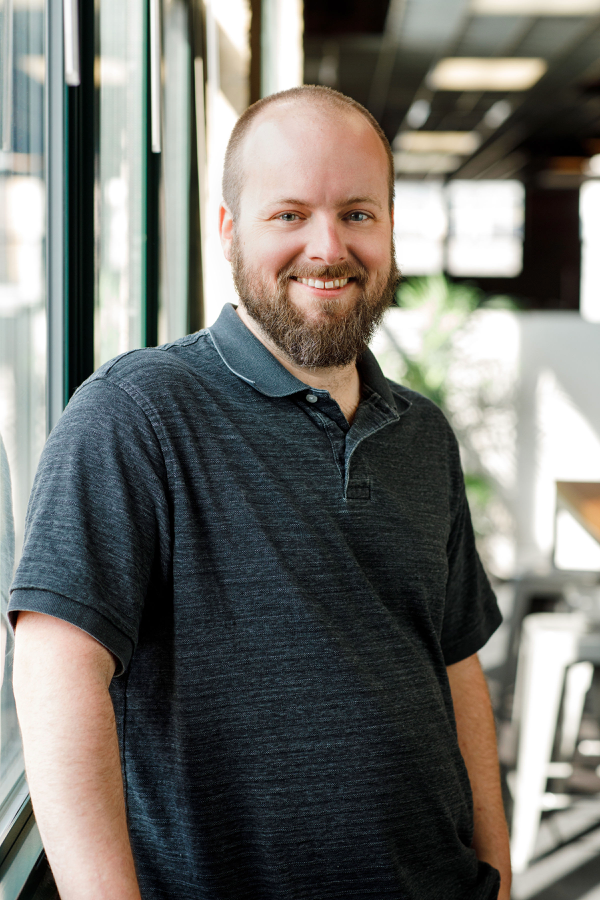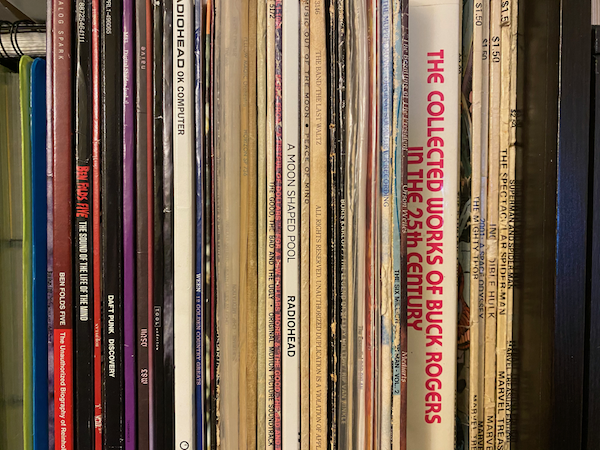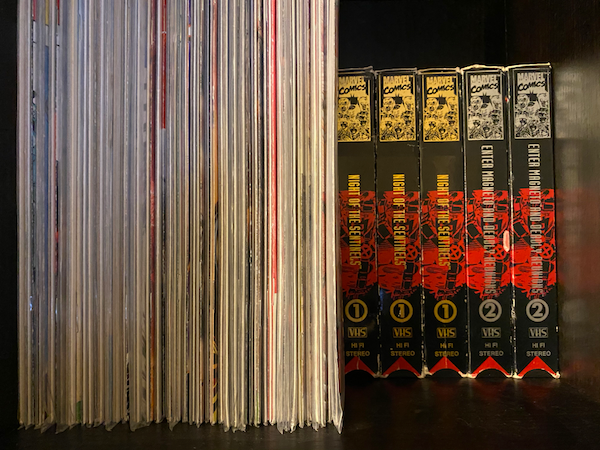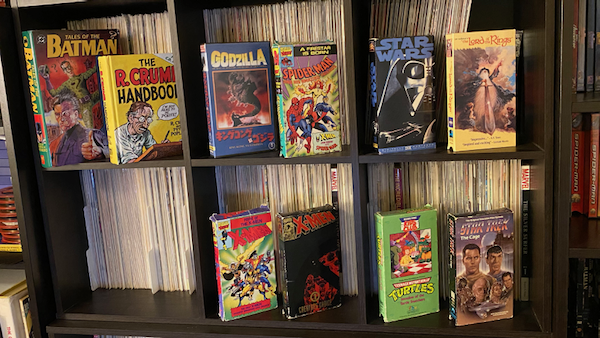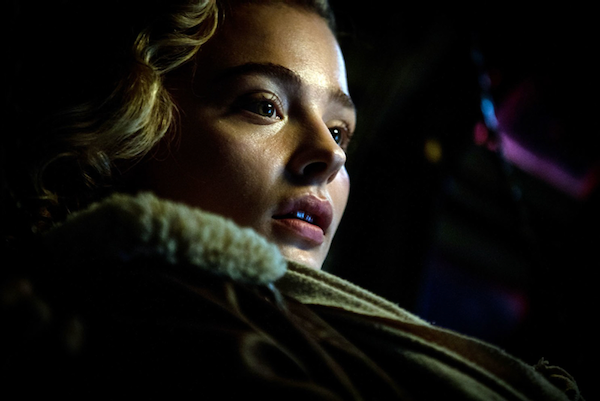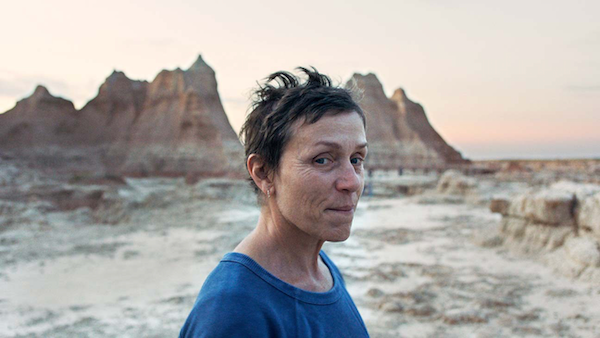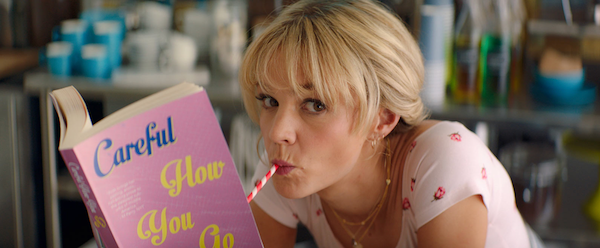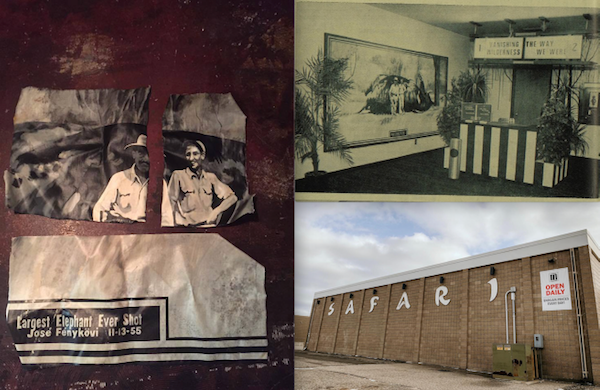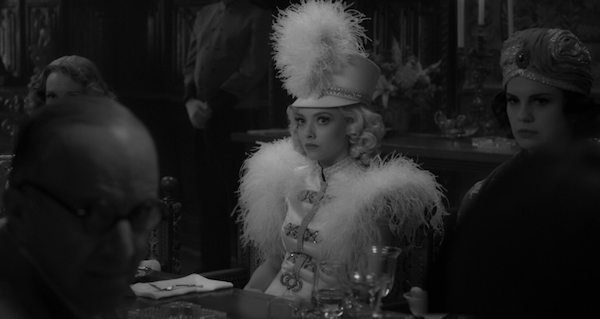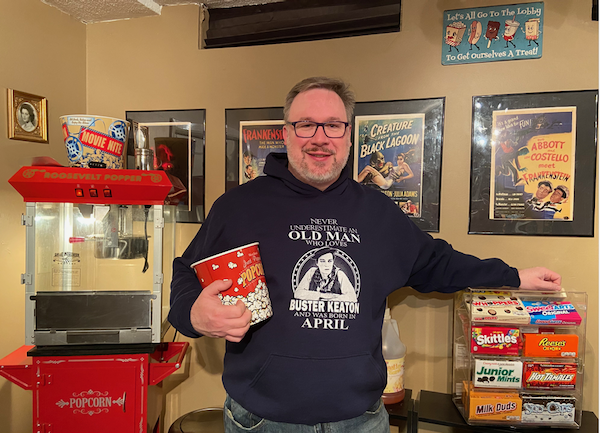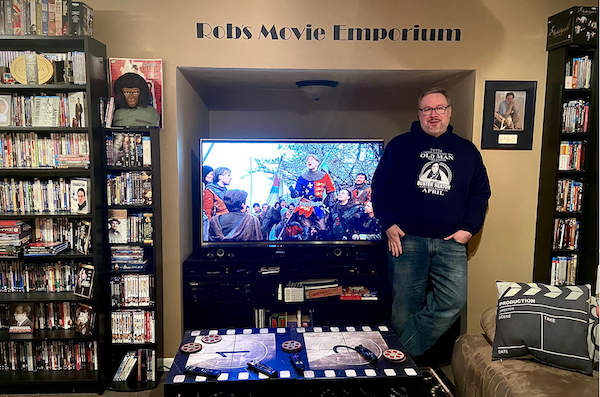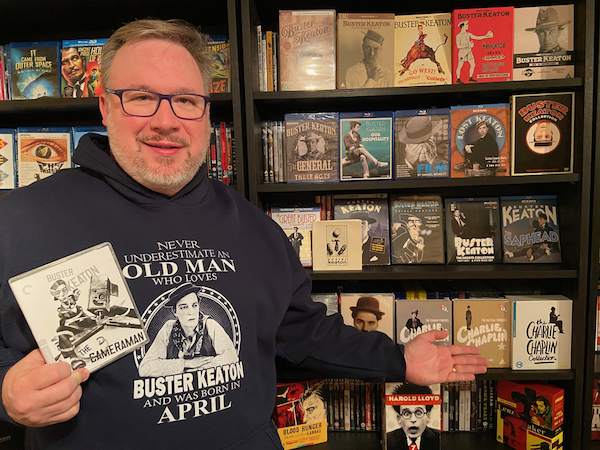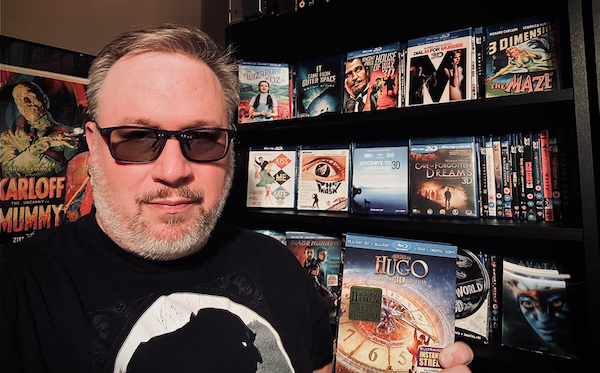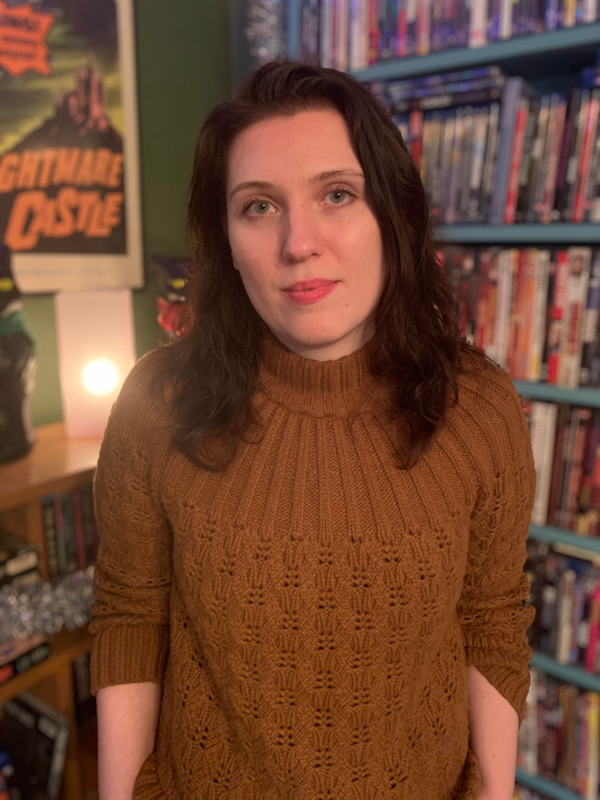
Interview by Greg Carlson
Alicia Coombs is an archivist and the head of business affairs for the American Genre Film Archive in Austin, Texas. Outside of watching and collecting movies, she likes to drink coffee, read about cults, and turn down plans so she can hang out with her cats instead.
Greg Carlson: How did you get into movies?
Alicia Coombs: I was raised to love movies. There are a lot of collectors in my family. My uncle, who I am really close to, is a collector. The beginning of my collection started with hand-me-downs. My family and I are indoor people — we’re not going on many ski trips.
When we went to the video store, my mom would look through everything and pick stuff out. She does not care who directed the movie. She does not really care about the movie’s history. She just likes movies. So she might select anything — which led to some unexpected choices, maybe not always the best choices, but then there would also be gems. I loved discovering movies with her.
GC: What was your electrifying early viewing experience?
AC: My mom rented a large pile of movies and David Lynch’s “Lost Highway” was one of them. I was in junior high at the time, about thirteen or so. She started the movie and almost immediately went, “Uh, no.” But after she went to bed, I put it back on. A mind-blowing movie experience.
GC: I love it. Did you have sources outside your family for discovering films?
AC: I read Spin magazine. In one issue, around the time I saw “Lost Highway,” there was an article about Doris Wishman that just fascinated me. I had no access to her movies then. They were adult titles and not available to me. But I was obsessed. I would go to school and try to talk about Doris Wishman. The kids at the lunch table didn’t care.
GC: My first Doris Wishman experience was courtesy of Jonathan Ross and “The Incredibly Strange Film Show.” The series was on really late, but every week I would stay up to watch it and most of the time I remembered to record to VHS.
AC: My love of Doris Wishman is going to come full circle, and I can tell you that fans of hers are going to be happy in the near future.
GC: Yes! That is especially good news. What is your go-to Wishman?
AC: I like the black and white ones the most. The roughie period of exploitation is my favorite. “Bad Girls Go to Hell” is at or near the top of the list. “Indecent Desires” is great. I like telling people about “Indecent Desires” a little bit more, because “Bad Girls Go to Hell” has such a dark theme that it might not be for everyone.
“Indecent Desires” still has a dark theme, but it also has a blonde voodoo doll that our psychotic main character utilizes for nefarious purposes. “Indecent Desires” heightens the weird, which Wishman is so good at.
GC: Where did you acquire films when you were getting started?
AC: When I started collecting with my uncle, Suncoast was the main place. And they had more than just mainstream content for sale. I remember the Redemption Films titles, Jean Rollin films. So instead of going to the mall for more common adolescent purposes, I was searching for something new, something I hadn’t heard of, at Suncoast.
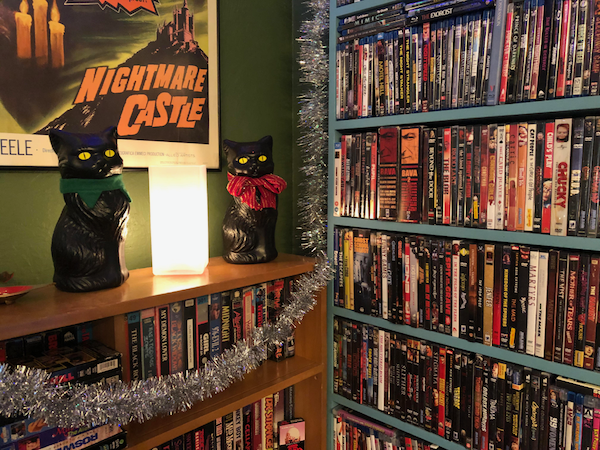
GC: What movies did you really want to have on your shelf?
AC: When I discovered Something Weird my collection really started. You could order online, and the catalog was so deep. I was too late for the VHS era, but the Image DVDs were so lovingly packaged. Triple features and great blurbs. You felt like you could have the whole drive-in experience with all the bonus shorts and trailers and all that good stuff.
GC: Another great episode of “The Incredibly Strange Film Show” featured Herschell Gordon Lewis. My friend Matt and I immediately tried to track down as many of his films as we could. We watched “Blood Feast” so many times I lost count. And the Something Weird compilation samplers were so much fun. I still quote lines from them. I am so glad that AGFA has a collaboration with Something Weird.
AC: Doris Wishman was the starting point on my journey to AGFA. I’m from Maine, and there’s a really great record store chain in northern New England called Bull Moose Music. Pretty soon, all my collecting was happening at Bull Moose. There was a wall of films and you would just go along the wall, discovering.
I had a DVD of “A Night to Dismember” and I read every word on the packaging. I would devour those booklets. I realized that the “A Night to Dismember” DVD was made by a Maine company. I was like, “Why and how is there a DVD company in Maine?” I tried to call them up and ask for a job, like any fresh-out-of-college person does. The response was “Two people work here. We don’t have anything for you.” [laughs]
GC: From Maine to Texas.
AC: I’m in Austin now where AGFA is based. I knew the guys who work at AGFA through the cinema scene and Alamo Drafthouse. I used to be a projectionist in high school and college. I also worked in film and television production in Austin. That’s what first led me to Texas. When I had time between gigs, I would offer to volunteer, since I had film handling experience. I found my way to accounting for film and TV, and it turned out that AGFA needed a full-time person to do that.
The Something Weird connection is special, since Something Weird is so critical to what AGFA does. We get to work closely with Lisa Petrucci. We have purchased some of their prints. We license some of their titles. It is a continuing collaboration. For AGFA’s own home video line, we love to help continue the Something Weird brand as well.
GC: How does working in a film archive intersect with or inform your own personal collection?
AC: The spirit is similar in that you really want to make sure these movies are available and accessible. You want them to be preserved. You want them to exist. People understand physical media. We want things to be ours. I don’t want streaming. That’s the worst! With streaming, a movie could just come and go.
Updating formats is part of collecting because you want something to last as long as possible in the best quality. Working in an archive affords the same sense of discovery experienced by the collector: saving things and protecting titles and making them available. AGFA’s mission is not just to save these movies but to make them available for people to see.
GC: How do you organize your personal collection?
AC: My husband and I collect together. And we also have a cinema at home. We bought our house because it had a big shed out back that we transformed into a cinema. We do have a spreadsheet for the Blu-rays, which currently number about 1500. But the spreadsheet does not have the collections and box sets broken out by separate titles.
I am not sure how many DVDs there are, since we don’t display most of the DVDs. There are some things, like TV series and seasonal stuff, that we set aside, especially if we don’t need regular access. VHS is a newer passion. We don’t have a huge amount — yet.
GC: Do you upgrade favorite titles to different formats?
AC: I’ve definitely purchased certain titles on multiple formats. For example, we’ve kept both DVD versions of “Lost Highway.” I think the reason is that one of them is pan and scan, which is awful, but the transfer is a little more visible than the image on the other DVD. Obviously, it is designed to be a visually dark movie.
So David Lynch gets repurchased. John Waters. It is so awesome those films are being reissued by Criterion. Some things are a joy to buy multiple times.
GC: How much time do you spend revisiting favorites versus seeking out something you’ve never seen before?
AC: Usually I will choose something I’ve never seen before. Certainly if I have people over, that is when I’m more likely to revisit favorites. Some movies are comforting. I relate to some movies seasonally. “All That Heaven Allows” is a Christmas movie. I’ll be watching that one again this year.
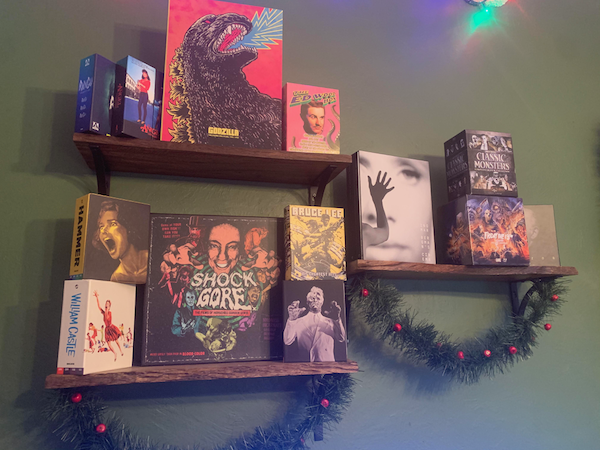
GC: What is your favorite genre?
AC: I love horror. Psychological or supernatural horror especially. I love a lot of cult and exploitation. Russ Meyer. Doris Wishman. Where camp and exploitation meet is my favorite zone.
GC: Since you mentioned supernatural horror, and because you have a “Possession” tattoo, I have to ask what is special to you about that film.
AC: In 2012, when I moved to Austin and attended repertory screenings, it was really a new world — experiencing movies with other people as opposed to purchasing movies and watching them on my own. “Possession” was screening at that time and was brand new to me. Movies can be so impactful on the big screen. “Possession” was spectacular in a way that very few films had been. It had been a few years since I had a transcendent movie experience. So there was that.
I’m also into film poster art and Basha’s Medusa image — which is so closely associated with the film — is so beautiful, and I like her work specifically. I love that the image kind of relates to the movie, but a lot of the Polish film poster art is very much its own thing. Sort of a reference to the movie. I liked the connections between all those things. That image stuck with me, and I thought about it for a couple of years — yes, I really do want this.
GC: The tattoo is just spectacular.
AC: Thanks. I’m hoping to get Basha’s poster image for “Twins of Evil” on my other arm. It’s another evocative symbol that I like, along with the movie. For that one, the movie might be secondary to the image, but there’s still a relationship between the two.
GC: How does AGFA determine what to preserve and release?
AC: A lot of the content comes out of the physical archive, which was collected by Tim League of Alamo Drafthouse. We have about 3000 prints, and there are so many different things. There was a period of discovering what exactly was here. By the time I joined the team there weren’t really any more mysteries.
There were years where there were “reel one” parties. You’d grab the first reels of several different films from the archive to see what you might have. If something stood out, you’d come back the next night to watch the whole feature.
Rights are always an issue. Along with Something Weird, we’re connected to Bleeding Skull, so lots of shot-on-video stuff is discovered through Joe Ziemba, the director of AGFA. We focus on films owned directly by the filmmaker. As long as they have materials, we can work with them and get things released.
GC: What are some must-have AGFA releases?
AC: My favorite is “The Films of Sarah Jacobson.” It’s a slightly different area for us. She was a 90s underground filmmaker who made her work when she was very young. Unfortunately, she is no longer with us. She was mentored by George Kuchar in San Francisco. The disc has a short, “I Was a Teenage Serial Killer,” and the feature “Mary Jane’s Not a Virgin Anymore.”
They both explore coming of age themes and feminist themes. Jacobson would probably hate to be called a punk or a riot grrrl or any sort of label like that. But to give you an idea, the films have an underground sensibility. And she’s working adjacent to genre, doing horror and B-movie stuff. She incorporates flights of fancy and scenes of melodrama. Incredible films.
Another title I love is our most recent, “She Mob.” It’s a shot-in-Texas roughie about a gang of female prison escapees kidnapping a gigolo for ransom. I love a movie where the lead is the villain, and Big Shim makes this one a true standout of 60s sexploitation. Introducing this film at Fantastic Fest with Lisa Petrucci was a real high point for me.

GC: What is the best item in your personal collection?
AC: It is so hard to pick one item. I have a VHS tape of “Two Small Bodies,” which I found at Vulcan Video here in Austin. The marketing is pretty standard erotic thriller stuff. And that’s a genre I poke around in. I didn’t know anything about it when I first put it in the player. For one thing, it’s a Beth B. film. I knew her earlier video works. But I had not known about her feature film works, and certainly not this one.
“Two Small Bodies” is based on a play, so it’s really just two actors, Fred Ward and Suzy Amis. The dialogue is on another plane. It’s just a thousand times weirder than what you would expect when you pop in something you think is a made-for-cable erotic thriller. It is a movie I tell everyone about. If I could, I would keep it in a purse and carry it around with me to push on people because I bring it up so often.
GC: I need to go watch it right now.
AC: I did speak to Beth B. and “Two Small Bodies” has been purchased by a label, so a Blu-ray could be available sooner rather than later. In the meantime, I’ve got my VHS copy.

